September 2019
volume XXVI number 7
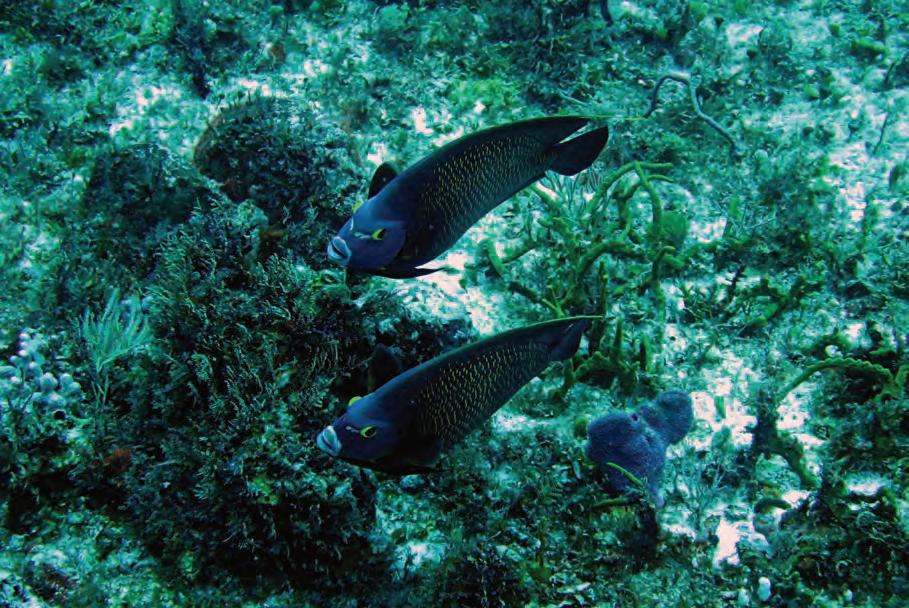
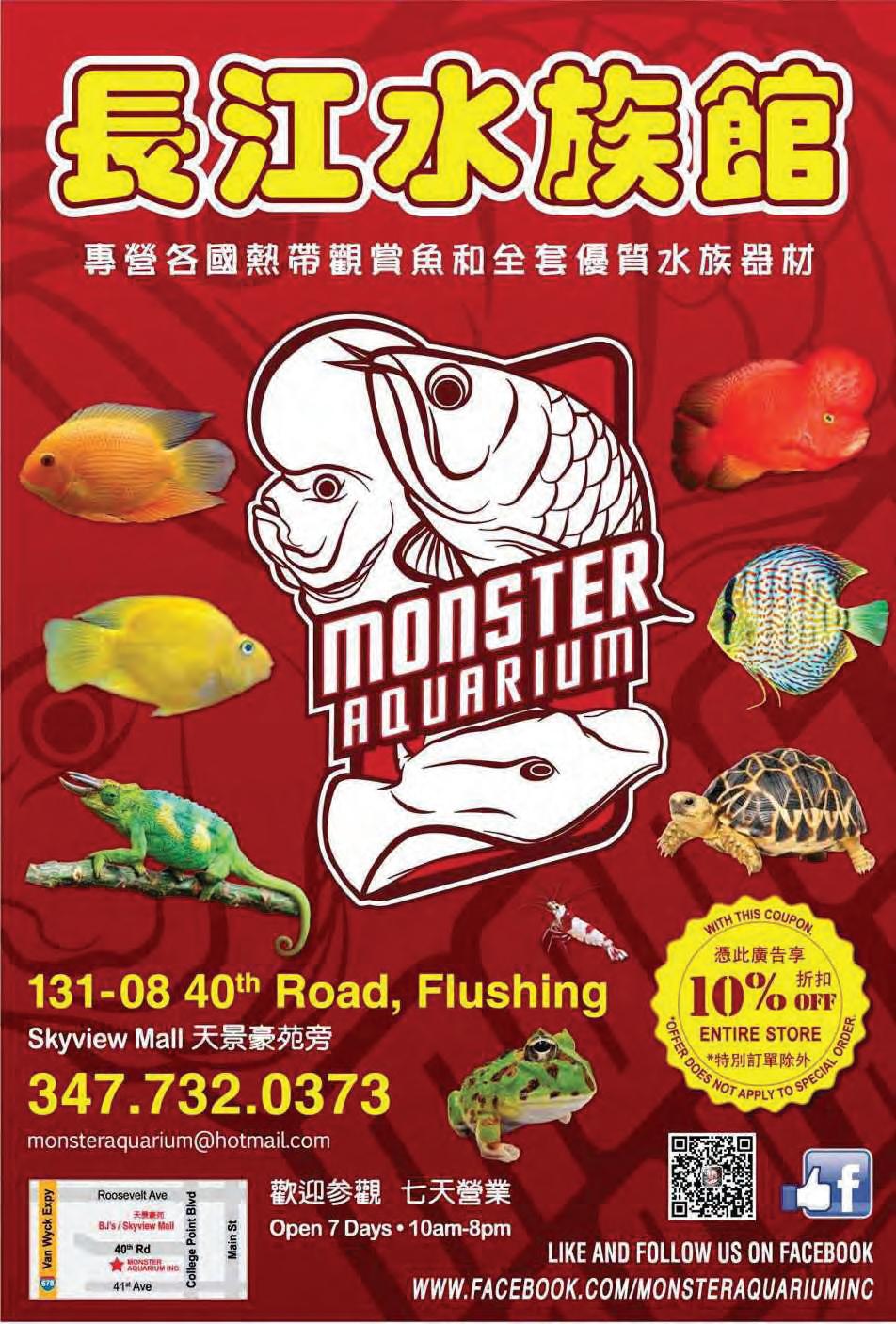
ON
Our cover photo this month shows a pair of French angelfish, Pomacanthus paru, in their natural habitat. See Steve Sicaʼs article, “Cozumel Express,ˮ on page 11, for more photos and information about the underwater world around Cozumel, and how to have fun there.
Pete D’Orio Walter Gallo
Al Grusell
Jason Kerner
Graffagnino
In This Issue From the Editor 2 G.C.A.S. 2019 Program Schedule 3 President’s Message 4 Last Month’s Caption Contest Winner 5 Pioneering Aquarist 7 The Legacy of William Holbein by Joseph Ferdenzi Cozumel Express 11 by Stephen Sica Our Generous Sponsors and Advertisers 16 You've Been Slimed! 17 The Attack of the Blue-Green Algae by Evelyn Egan Fishy Friendsʼ Photos 19 G.C.A.S. Bowl Show Rules 20 Why Did the Turtle Cross the Road? 21 by Ronald G. Webb Pictures From Our Last Meeting 22 G.C.A.S. Member Discounts 24 G.C.A.S. Classifieds 27 G.C.A.S. Happenings 28 The Undergravel Reporter 27 Pooping With the Fishes Fin Fun (Puzzle Page) 28 Once Up Pond A Time Series III Vol. XXVI, No. 7 September, 2019
THE COVER
CITY AQUARIUM SOCIETY Boa R d M EMB ERS President
Photo by Stephen Sica
GREATER
Horst Gerber Vice-President Edward Vukich Treasurer Jules Birnbaum Assistant Treasurer Ron Wiesenfeld
Corresponding Secretary Vinny Ritchie
M EMBERS at La RG E
Victor Hritz
Leonard
Co MM itt EE Ch ai RS
Joseph
Joseph
Ramroop
Bowl Show
F. Gurrado Breeder Award
Programs
Gilberto
Technical
Editor in
Dan
Copy Editors: Alexander A. Priest Susan Priest Donna Sosna Sica Thomas Warns Advertising Manager Larry D. Whitfield
Early Arrivals Al Grusell Membership Marsha Radebaugh N.E.C. Delegate Joe Gurrado
Social Media
Soriano
Coordinator Jason Kerner MODERN AQUARIUM
Chief
Radebaugh
From the Editor
by Dan Radebaugh
Ilike this issue of Modern Aquarium. I believe youʼll find it to be diverse and well-rounded. Some of the authors you’ll recognize, others perhaps not. For instance Ron Webb has in the past submitted winning captions for our monthly cartoon caption contest, and some photos for our Fishy Friends Photos, but I’m pretty certain that this is the first actual article that Ron has submitted. I think you’ll like it. Thanks, Ron, and keep up the good work!

The main topic of my column this month is our club’s membership, about which I’ve heard a lot of speculation lately. Is it holding steady? Increasing? Shrinking? The discussions I’ve heard or read typically break down to optimism vs pessimism. The optimists insist that membership is better than ever, while the pessimists assert that membership is fading and we’ll be lucky to last another two years.
I’m pretty sure that I’m not the only one here who has noticed that our meetings over the past few years have become more crowded than they once were. Iʼve also had to print more copies of Modern Aquarium for the past few years, so I asked my wife Marsha, our membership chairperson, if she could generate a report from her records so that we could have some ‘metrics’ (for you baseball fans) to show us in detail what has been going on. Well, she really couldn’t, as we simply have not felt the need to set up an ‘auditing’ process.

Both Marsha and I worked for many years in the magazine publishing industry, and we are accustomed to keeping fully auditable circulation data. It was essential for us to be able to prove we were sending the expected number of issues to a specific audience, and within a specific time frame. Here, that level of record keeping is simply not necessary. That being said, I do need to know how many issues of Modern Aquarium to print, and the club does need to know how many members we have.
Marsha informs me that our current number of memberships is 103. I consider that to be pretty strong. What isn’t always easy to know is exactly how many people come to a given meeting. Not everyone bothers to sign in with Marsha every meeting, and people trickle in after the meeting has begun, so sometimes even she doesn’t know how many people are actually there. It's been looking to me as though we perhaps need to add a couple more rows of seats down front, where we have some additional space. There certainly isnʼt any more space at the back.
Some of us have made informal head counts over the past couple of years, and those ‛unoffical estimatesʼ have ranged from 75 to 95 per meeting, which seems roughly accurate to me, though itʼs hard to really tell, because of things like people getting refreshments, chatting out of sight, head calls, and so forth. Clearly then, we are doing very well in the area of membership. We’ve also been getting quite a few younger new members, which I find a very positive development, since old coots such as myself have a finite remaining shelf life, and I’m not even close to being the oldest of that ‛old cootʼdemographic.

Modern Aquarium - Greater City A.S (NY) 2 September 2019
GCAS Programs 2019
It is our great fortune to have another admirable cast of speakers who have so graciously accepted our invitation to join us throughout the coming season, bringing us their extensive knowledge and experiences. You certainly won’t wish to miss a moment of our prominent guests, not to mention the friends, fish, warmth, and camaraderie that accompany each meeting.
March 6 Gary Lange
Cruising Papua - Following New Roads and Exploring “The Bird’s Head”
April 3 Mark Denaro
Cichlids I Hate
May 1 Harry Faustmann Live Foods
June 6 (thursday)
Breedersʼ Forum
Moderated by Joseph Ferdenzi
July 3 Joseph Ferdenzi
The Story of Endler ’s Livebearer
August 7 A Night at the Auction
September 4 Tom Keegan
Spawning Various Types of Tropical Fish
October 2 Jim Cumming
Madagascar and Indian Cichlids
November 6 Greg Steeves TBA
December 4 Holiday Party!
Articles submitted for consideration in Modern Aquarium (ISSN 2150-0940) must be received no later than the 10th day of the month prior to the month of publication. Please email submissions to gcas@earthlink.net, or fax to (877) 299-0522. Copyright 2019 by the Greater City Aquarium Society Inc., a not-for-profit New York State corporation. All rights reserved. Not-for-profit aquarium societies are hereby granted permission to reproduce articles and illustrations from this publication, unless the article indicates that the copyrights have been retained by the author, and provided reprints indicate source, and that two copies of the publication are sent to the Exchange Editor of this magazine. For online-only publications, copies may be sent via email to gcas@earthlink.net. Any other reproduction or commercial use of the material in this publication is prohibited without prior express written permission.
The Greater City Aquarium Society meets every month except January and February. Members receive notice of meetings in the mail or by email. For more information, contact: Dan Radebaugh at (718) 458-8437, email gcas@ earthlink.net, or fax at (877) 299-0522. For more information about our club or to see previous issues of Modern Aquarium, you can also go to our Internet Home Page at http://www.greatercity.net, http://www.greatercity.org, or http://www.greatercity.com.

Modern Aquarium - Greater City A.S (NY) September 2019 3
President’s Message
 by Horst Gerber
by Horst Gerber
Night at the Auction – 2019 – Random Words, Better Words, and Sentences!
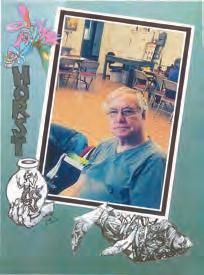
Crowded! Chairs all taken up. Standing room only! Aisles crowded with hobbyists eager to bid. Spend money! This year’s auction saw a record number of auction items: manufacturers’ donations, Florida Aquatic Nurseries, fish from members and breeders alike, many barely missed opportunities, joy, successful bidding, stepping up to the plate!
It seemed like there were twice as many people as usual. I may be overestimating, but let me keep my illusions. Last year was supposed to have been the all-time attendance record (If You Build It, They Will Come). It shows you that if you put on a good auction people will come! Before the auction began there were shoulder-to-shoulder onlookers crowding around the auction tables, taking notes and writing down items and lot numbers. There was a record number of home-bred fish from our members as well as from members from other clubs. Let’s also not forget all the brand-new aquarium equipment and foods donated by sponsoring companies. Our sponsoring companies are listed in Modern Aquarium, as well as on our website, so be sure to look them up and patronize them when possible.
As I write this I haven’t seen the final numbers yet, but it isn’t crazy to think that this auction might have been our biggest ever! It was not just another auction with mere mortals scratching off lot numbers on their notepads and marking off successful biddings. At least there was no bloodshed among competing bidders. Maybe a few friendships went down the drain, but that’s all—I’m not mentioning names.
So as I write this the morning after (writing and rewriting!), and Dan is compiling notes to write his Editor’s column, and Jules is computing the amount he has to pay our donors, all the drama seems to be well worth it, and our club remains financially sound, as it has been for many years now.
A couple of months back I mentioned in this column that we need some members to step up and volunteer for some of the jobs we need to fill to keep our club running well. Please take a look at that list again and let me know if you are willing to help out. I am very thankful that there are members who are willing to pitch in! Remember, our 100th year of existence is just around the corner. Keep this club great!
See you next month!
Horst


4 September 2019 Modern Aquarium - Greater City A.S (NY)
August’s Caption Winner: Warren Feuer

Itʼs a well known fact that owners and their pets begin to resemble each other over time.
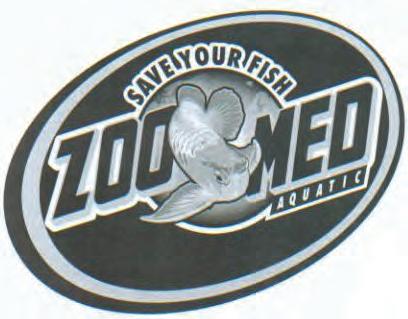
Modern Aquarium - Greater City A.S (NY) September 2019 5


Modern Aquarium - Greater City A.S (NY) 6 September 2019
Pioneering Aquarist The Legacy of William Holbein
by Joseph Ferdenzi

In the early days of the aquarium hobby in America, New York City was the epicenter of its activity. The first two aquarium books published in America were both New York City imprints. Moreover, the very first aquarium society organized in America was the one established in New York City in 1892. Its preeminence was such that it was simply referred to as “The Aquarium Society.” This preeminence was due not only to the fact that it was the first. Among other factors was its location, Manhattan—at that time the most bustling and wealthy metropolis in the USA. For another, its meetings took place at a very prestigious location, the American Museum of Natural History, located on Central Park West. Lastly, New York City was home to many German immigrants, who brought their love of the aquarium hobby to these shores.
Among these German immigrants was a young man by the name of William Holbein, who was born in 1876 or 1877 (there is some confusion in the records as to which is correct). By the time he was about 18 years old (1895), he was already living in New York (photo above). Holbein was an upholsterer by trade (photo below from circa 1930), and had a shop that provided interior decorating services located in the vicinity of 125th Street and Amsterdam Avenue in Manhattan (in the area known as Harlem).
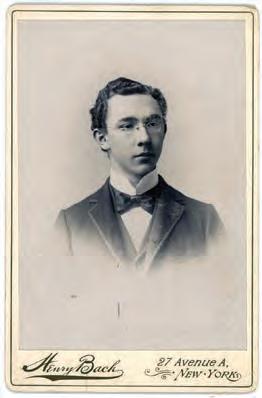
At some point Holbein became a very active member of The Aquarium Society. Thanks to a New York Times article of August 31, 1924, we know that
Holbein, at the relatively mature age of 47, won a prize at their show for the best “balanced tank.” That prize took the form of a medallion with his name engraved in the center (photo 3, below). As you can see from studying the medallion, the society refers to itself as “The Aquarium Society,” New York, and carries the date of September 1924 (according to the Times article, the show officially closed on September 1). We only know what it was awarded for because of the Times article published the day before the show closed.

Thanks to another New York Times article, this one published on January 26, 1929, we know that Holbein was elected President of the society that year. Of additional significance is that he succeeded Richard Dorn, who had been the President since 1908. Dorn is prominently featured in Albert Klee’s monumental work, The Toy Fish: A History of the Aquarium Hobby in America. In Klee’s opinion, Dorn is one of the “five greatest American aquarists in the history of the hobby.” So for Holbein to be elected to succeed him certainly indicates the high esteem in which Holbein was held by the society’s members. The Society was very prominent in its day. As yet another New York Times article (this one published on August 28, 1933) points out, among its active members was S. S. Van Dine, of whom I’ve written before. Van Dine was one of America’s most popular fiction writers in the 1930s, and he and his wife maintained some 40 aquariums in their duplex apartment on Central Park West. For further insights into Van Dine’s immersion in the aquarium hobby, read his 1934 novel, The Dragon Murder Case.
Holbein served again as President as late as 1942 (see photo 4 on following page, a “certificate award” which bears his signature as President). Clearly, Holbein was an important member of the Society until
Modern Aquarium - Greater City A.S (NY) September 2019 7
Photo 2: Holbein, c 1930
Photo 1 William Holbein, circa 1895
Photo 3
he moved to Florida sometime before 1948. Yet as we can tell from an article he wrote for The Aquarium magazine that was published in September, 1946 (see facing page), he continued to be active in the hobby. There can be no doubt that aquarium keeping was a life-long passion for him.

During his time in New York Holbein’s prominence was such that he was asked to be one of the judges at the 1932 show of the Greater City Aquarium Society. In those days Greater City had one of the most highly attended shows in New York, and only the most highly-regarded aquarists were asked to serve as judges. These judges were presented with sterling silver medals that had their names engraved on the reverse side (photos 5 and 6 below). I have previously written about another such medal, from 1933, that was given to a very prominent aquarist, C.H. Peters. In a happy coincidence, we have a first-place gold medal awarded to Carl Kaplan at that 1932 show which was
the subject of another prior article. How wonderful to know that Holbein’s medal is linked to Kaplan’s medal by virtue of Holbein’s role as a judge at that show. That Holbein was active on the show circuit is also reflected by a medal he possessed from the long-defunct Westchester Aquarium Society (photo 7 below). Unfortunately that medal contains no date or other information to indicate what it was awarded for.
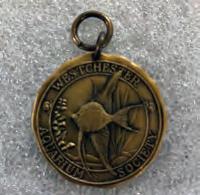

Among Holbein’s other prize possessions was a set of four remarkable china plates (photos 8, 9, 10, and 11). These plates were manufactured in Meissen, Germany, a city renowned for its china. But then, remarkably, they were handpainted by a member of The Aquarium Society. All we presently know about the artist is that he was of Japanese descent—this according to Holbein’s widow. Unfortunately his name does not appear on the plates. (If this account is correct, it is curious that on the back of each plate, above the Meissen logo, is the German word “Handmalerei,” which means “painted by hand.”) Each of these plates bears a beautiful image of an aquarium fish. The one plate dated 1926 features a pair of jewel cichlids (Hemichromis bimaculatus) with their fry. The other three plates, all dated 1927, display, respectively, a pair Story continues on page 10...

Modern Aquarium - Greater City A.S (NY) 8 September 2019
Photo 4
Photos 5 & 6
of American flagfish (Jordanella floridae), a banded sunfish (Enneacanthus obesus), and a pair of paradise fish (Macropodus opercularis). Why these plates were commissioned is unknown for certain, but my best guess is that they were awarded as prizes at The Aquarium Society’s annual shows. Regardless of the

reason, these remarkable plates are a beautiful legacy from a time when the aquarium hobby reigned in New York, and The Aquarium Society was its most noted representative. We are forever indebted to William Holbein for having preserved this tangible evidence of those glorious days!



I wish to acknowledge that this article was made possible by the generosity of William Holbein’s grandson Hans (Bill) Holbein, Jr. Bill, as he prefers to be called, is an avid cane-rod fisherman who lives in North Carolina. He contacted me via our website. All the photographed artifacts are now in my possession, thanks to him. Also, all the biographical information that is not attributed to other sources came from Bill. Bill was only 10 years old when his famous grandfather passed away in 1952. But Bill does remember one piece of advice his grandfather gave him: “to be a good fish breeder you need a hungry cat.” I happen to know that the legendary German-American guppy breeder Paul Hahnel also believed in that. The late Gene Baiocco personally witnessed Hahnel feeding “inferior” guppies to his house cat!
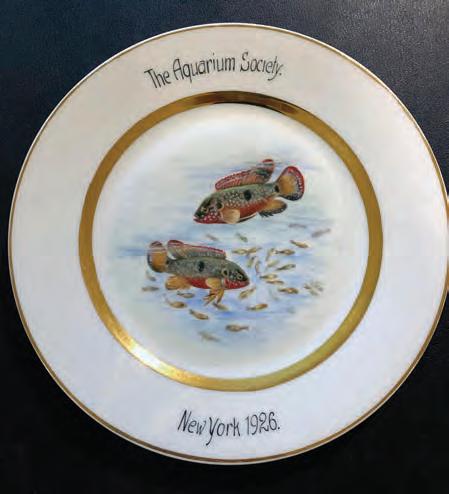
Modern Aquarium - Greater City A.S (NY) 10 September 2019
Cozumel Express
Story
Last May Donna and I went on a four night cruise from Fort Lauderdale, Florida to Cozumel, Mexico and back. For the day that we visited Cozumel we decided to go diving. Our most recent diving excursion to Cozumel had been about seven or eight years ago—maybe more. Cozumel offers a variety of dives. Many of them are high speed drift dives at speeds up to three knots. It can be exciting, but also strenuous, and we’re not as fit as we were a few years ago, despite our modest workout regime.
After we docked and exited our cruise ship, the Caribbean Princess, we walked down the pier and met our tour guide. Only three of us from the ship had signed up. We sat at a picnic table and completed our dive liability waivers, and then we were led back to the waterfront where we watched our dive boat approach. It picked us up, cast off, and motored down the shoreline for a few minutes to the dive shop, where additional divers and more crew members boarded.
Soon we cast off and headed up the coast to Cozumel’s national park reserve. The trip took about forty minutes. We were briefed about the pending dive on the way to the site. Dive sites are chosen by the captain, and often change. It depends on many factors, including the weather, current, visibility, depth
and underwater scenery. We were heading for deep water where the reef ended at a wall and a drop-off. These sites are usually farther offshore but Cozumel is surrounded by deep water fairly close to shore. This is typical of many deeper dive sites.
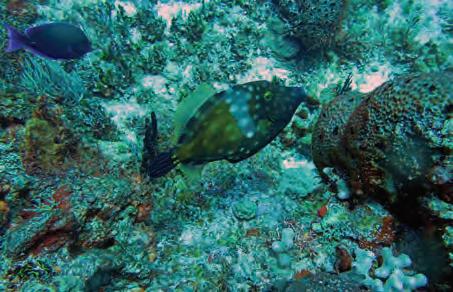
Two of our fellow divers were a couple from Poland. I found this interesting because Donna’s ancestry is Polish. I suggested that she bond with them, but she wanted to sun herself on the rear of the main deck. When we arrived at the site, Lead Divemaster Gilberto divided us into two groups. He would lead Donna, me, and two other men.
Divemaster Fatima would lead the remaining four divers.

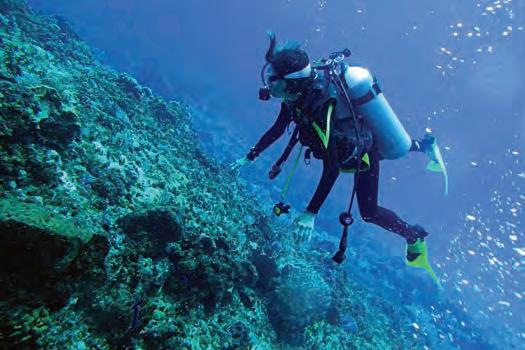
We geared up and quickly jumped off the transom. The current was running at least two knots. Because of the current, it was important to submerge quickly and join up underwater. I immediately noticed that I was buoyant using the dive shop’s equipment. The twelve pounds of lead weights that I wore were insufficient to submerge easily, so I kicked up my fins, exhaled deeply to empty my lungs and headed towards the seafloor.
Gilberto led us to a wall at eighty feet. I kept one eye on Donna and tried to prep my camera while flying through the water. If I found a photo subject I
Modern Aquarium - Greater City A.S (NY) September 2019 11
and Photos by Stephen Sica
Donna alights on the bottom at 80 feet near the edge of a deep wall ready to begin our dive.
A Whitespotted filefish, Cantherhines macrocerus, stops by to pose for a photo. These fish usually travel in pairs although I didn't see a mate. This fish often demonstrates a reddish coloration. It feeds on sponges and stinging corals. If you have difficulty identifying, look for its black tail. Length is about eighteen inches.
A pair of French angelfish, Pomacanthus paru, understand that streamlining helps their stability in strong currents. While most fish don't seem to be hindered by the current, these angelfish are savvy enough to go with the flow.
was able to hold my position, but did not have enough energy to swim back into the current. After a while, I noticed that I was using my air at a high rate, so I ceased resisting the current. If I saw something or Gilberto pointed out a photo subject, I either let it go or pointed my camera in the general direction and just clicked away at long range and wide angle. I was annoyed, because I was unable to take many quality photos.
My annoyance grew by leaps and bounds when I glanced at my pressure gauge and saw my air supply rapidly dwindling. I couldn’t stay deep any longer and signaled Gilberto. We swam up and onto the reef at about sixty feet; this would extend my air supply. Donna was fine, but I lost track of the two other divers. When I had seen them ten minutes earlier they appeared to be okay, but right now I was concerned with staying with Donna and the divemaster. He was carrying a deflated signaling float. When you dive with a strong current, the dive boat follows your bubbles. Both groups had stayed together underwater, but as the dive progressed we became separated. At least I could not see anyone else. The current also stirs up particles in the water, reducing visibility. My primary goal was to keep track of my air and Donna. After a few more minutes I

There were two Goliath groupers, Epinephelus itajara, about thirty feet away. I tried swimming to them but was unable, so I held my camera at arms length and took several photos as the current pushed me away. I managed to frame one grouper. Considering they average four to six feet with eight feet maximum, I think that I mistook large black rocks for these fish.

A pair of queen angelfish, Holacanthus ciliaris, and a black durgon, Melichthys niger, hover near what I think may be misshapen giant barrel sponges, Xestospongia muta. These fish appear to have no difficulty swimming against the strong current.


glanced at my pressure gauge. My eyes almost bulged from my face. On my next inhale the needle moved from 700 psi (pounds per square inch) to about 300. I thought that I was sucking the last air out of my tank, but then I noticed that the needle would move down and go back up when I exhaled. I was worried, and watched the needle fluctuate for three breaths before I was confident that my air cylinder still had sufficient air. I looked around and saw Gilberto about ten feet below me and to my left. I began the dive a bit too buoyant, and was beginning to have difficulty staying down. The air in a standard scuba tank weighs about five pounds, and I had breathed almost four, so now I was positively buoyant. Gilberto signaled to me “How much air?” and I responded 700 psi with my fingers. He told me to surface.
Donna was too far away for me to tell her that I was surfacing, but she saw me ascend and swam towards me. I never run low on air, so she did not comprehend that I was in fact doing so. I had intended to hover in the open water at twenty feet to make a three minute safety stop, but after one minute I was so buoyant that I floated to the surface. She joined me without her safety stop, and I told her that I was extremely low on air. As we floated on the surface,
Modern Aquarium - Greater City A.S (NY) 12 September 2019
Gilberto, our Lead Divemaster, checks out a cave inhabited by a school of grunts among other fish. He was trying to find photo opportunities for me.
Gilberto led me to a juvenile spotted drum, Equetus punctatus, swimming to and fro in front of coral and its small home cavern. This fish is always an attractive subject, if it would only stay still!
I scanned the wave tops for our boat. A short time later I saw a boat heading towards us and assumed that it was coming to pick us up. Thank goodness I was right, and we clambered aboard. Two divers from Fatima’s group were already aboard. They had entered the water after us, but returned first. Donna asked me where they came from, but I had no clue. Soon Fatima and her two remaining divers boarded, and finally the two divers from our group who had disappeared climbed onboard with Gilberto. Times like this remind me of that motion picture from several years ago where the dive boat leaves a husband and wife behind in the water and no one notices that they are missing. The movie was based on a true story.
Once everyone was aboard, our boat motored on to the location for our second dive. We rested for forty-five minutes to allow our bodies to de-gas some of the nitrogen that we had absorbed, while our captain searched for calmer water. I told Gilberto that I might need additional weight, and he said that I should begin the second dive and inform him when we were under
water, because like most divemasters he carried extra weights. A few minutes later we were back under the water. I signaled to Gilberto for more weights, and he slipped a two pound lead weight into my buoyancy compensator pocket. I slowly sunk to the bottom at sixty-six feet and looked up towards Donna, who was with Gilberto near the surface. When she had surfaced from her first dive she had some blood in her mask from a mild nose bleed. Two weeks earlier we had both developed head colds in Florida, and she was still feeling the effects, which interfered with her ability to equalize pressure on her descent. After a few minutes she disappeared, and our boat was now where she had been on the surface. I knew that she had aborted her dive and was being picked up. Gilberto swam down to me and the two divers in our group and signaled us to follow him. We swam about thirty yards, and I looked up to see the bow of a moderate sized shipwreck dead ahead.
We swam up, onto, and around the deck. I noticed Gilberto and another diver swimming towards




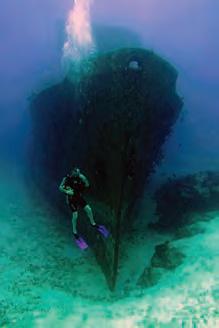
Modern Aquarium - Greater City A.S (NY) September 2019 13
After we descended for our second dive, Gilberto led a swim along the sandy bottom until we came upon a shipwreck whose name I never did learn. One of the four divers in our group poses in front of the bow, which gives you a general idea as to the ship's size.
We swam along the shipwreck's deck. I came upon a Spotted moray eel, Gymnothorax moringa, flashing its teeth as it poked its head through a hole in the deck.
Intrigued by the Spotted moray, I maneuvered around to get a better photo and include more of the eel in it.
Swimming in the water column near the shipwreck was a two foot long adult Queen triggerfish, Balistes vetula
Gilberto signals us to follow him along the deck. Since I don't correct my eyesight underwater, unlike on land, I wasn't sure where he was going. I assumed that I would follow the two other divers in our group who were behind me at the time
the bow, where I saw a dark oval that looked like an open doorway. The third diver, who was just ahead of me, headed off in their direction. I stopped to look into the open hold for photo opportunities. When I looked up a few seconds later everyone was gone. I swam after them, but when I reached the entrance where they had disappeared, I saw there were two doorways side by side. I hadn’t noticed two doorways when I was forty feet away. Where did the second one come from? I was alone, so I swam through the larger door on the right, and began swimming through passageways until I came to a dead end!
I told myself to stay calm, and looked at my pressure gauge. I had plenty of air, and I was less than sixty feet under water. I turned to my right and continued along the passageway until I was greeted by another dead end. I immediately backtracked. At the first dead end it dawned on me that I was swimming in partial light. I looked up and saw a small opening a few feet above me. I managed to get my head through into the “sunlight,” and eventually I was able to wiggle my body and air tank through the vent. I thanked King Neptune that I didn’t have to slip out of my air tank to squeeze through the opening. This was a stroke of good luck! I guess that the two days a week that we exercise at the local YMCA did some good after all! Once I was freed from the superstructure, I did not

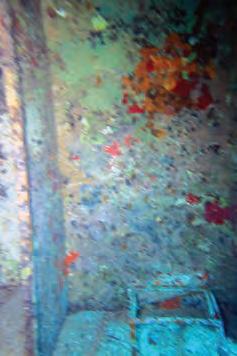

After we left the shipwreck and descended to the sand we came upon a colony of brown garden eels, Heteroconger longissimus, poking about four inches above the sand. This eel's average length is eight to fifteen inches. I scanned the seabed as we swam along and saw many colonies. As I approached, they would drop down into their burrows.

look back! I swam along the starboard side of the deck towards the bow, where I saw Gilberto on the port side of the ship. I could sense that he was looking for me, so I signaled that I was okay, and all four of us swam off the hull back down to the sand.
After we surfaced and were picked up, Donna told me that the captain and three dolphins were circling each other and playing tag while awaiting our return. I told Donna the shipwreck story as we headed back to our cruise ship. She chastised me, and declared that our days of drift diving in Cozumel were over. I reminded her that our nephew Christopher once referred to her as a “bathtub diver” due to her excessive caution.
After dinner and the show we visited the art gallery, and walked around the ship until bedtime. I wondered if I was getting too old to keep diving after fifty-seven years in the hobby. I know for sure that there is always an adventure just around the next coral reef, or shipwreck in this case, awaiting a person with a sense of exploration. In my mind I decided to continue to be “bold and go where no man has gone before.” Besides, I like swimming with the fishes and I think that I always will, so I’m not ready to quit.
I think that I slept well that night but I don’t recall. Sometimes, you really do need a short memory!
Modern Aquarium - Greater City A.S (NY) 14 September 2019
While I stopped to photograph a black margate, Anisotremus surinamensis, swimming along the deck, my dive companions disappeared somewhere into the ship.
Left: A steel wall greeted me after swimming through a passageway. It dawned on me that the other divers did not take this route! The photo is washed out by the closeness of my dive light and camera to the wall.
Another whitespotted filefish, Cantherhines macrocerus, with its foredorsal spine raised. Perhaps, it thought that I was a threat. A filefish cannot lock its spine into place. Also, note its extended stomach appendage in front of the long anal fin. This fish exhibits different coloration from the filefish that I photographed earlier.

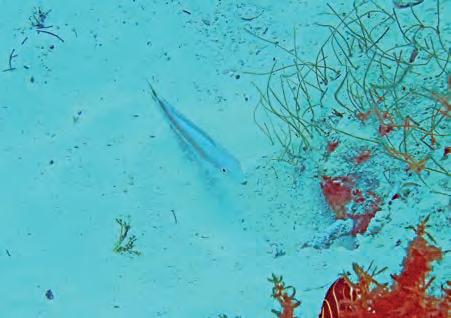
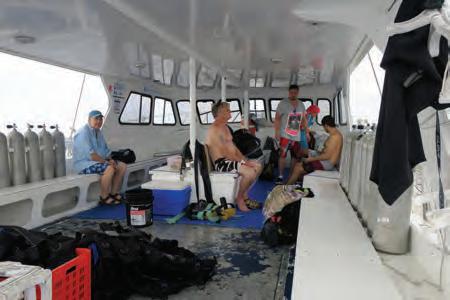



Modern Aquarium - Greater City A.S (NY) September 2019 15
Swimming along the sandy bottom near the wreck, I found a bar jack, Caranx ruber, circling a yellow stingray, Urolophus jamaicensis. The jack would swoop down onto the sand and nip the ray. I could not observe any reason for this behavior.
A sand tilefish, Malacanthus plumieri, hovers just above its burrow. If disturbed, it will dive in head first. After this photo, I ascended to the surface to conclude both an interesting and exciting dive.
Tired divers rest as our boat speeds back to the cruise ship dock after a long, hard day of diving.
Hello Caribbean Princess, and welcome to a warm shower and a delicious dinner!
Aquarium Pharmaceuticals
Aquarium Technology Inc.
Aqueon
Brine Shrimp Direct
Carib Sea
Cobalt Aquatics
Coralife
Ecological Laboratories
Florida Aquatic Nurseries
Fritz Aquatics
HBH Pet Products
Hydor USA
Jehmco
Jungle Labs
Kent Marine
Marineland
Microbe Lift
Monster Aquarium, Inc.
NorthFin Premium Fish Food
Ocean Nutrition America
Oceanic
Omega Sea
Penn-Plax
Pet Resources
Pisces Pro
Red Sea
Rena
Rolf C. Hagen
San Francisco Bay Brand
Seachem
Sera
Spectrum Brands

Zilla
Zoo Med Laboratories Inc.
Your Fish Stuff.com
16 September 2019 Modern Aquarium - Greater City A.S (NY)
You’ve Been Slimed! The Attack of the Blue-Green Algae
By Evelyn Egan
At one time or another all aquarists have had to deal with the blue-green slime known as cyanobacteria. I have had it more than once, and it is not pretty! It looks like blue-green colored algae that spreads all over your plants and decorations, and has a distinct unpleasant odor. It can be gotten rid of if you know what it is and how to deal with it, but if you don’t know, you can end up with a mess, and possibly dead fish and plants. I’m sure that more than one new aquarist has left the hobby because they didn’t know how to get rid of it, and gave up.

Antibiotics can be a quick and easy way of getting rid of this slimy mess, but the downside is that you can really throw the biological balance of your tank way out of whack and seriously hurt your fish. Also, each use of antibiotics increases the chance of making the bacteria resistant, so only use antibiotics as a last resort. Have some patience and use this method first. It works.
Let me start off by saying that cyanobacteria are in fact not algae, but as their name implies, bacteria. A mistake a lot of people make, myself included, is that the first time they encounter cyanobacteria they reach for an algaecide to treat it, and are surprised when it doesn’t work. The cyanobacteria group, also known as blue-green algae, is a large group of organisms, some green, some blue-green, and some red. These bacteria are found everywhere in nature— land, water, and air. It is one of the oldest life forms on the planet, dating back 3.5 billion years. Why has it survived so long? It makes use of light discarded by higher forms of plant life. Cyanobacteria absorb light between 550-700nm, still roughly the same as plants and green algae.
This is one of the reasons it thrives in our planted aquariums and is so hard to get rid of. It exists in a wide range of temperatures, and is tolerant of some extreme environments, such as hot springs, saline lakes, and even deserts. It subsists on organic wastes, including dissolved phosphates and nitrates, but it is not dependent on nitrates or ammonia, instead using molecular fixation (cyanobacteria make their own nitrogen). What do all these organisms have in
common? They exist in the artificial environments we call our aquariums. Cyanobacteria infestations are not initially dangerous to the inhabitants of our freshwater or marine aquariums, but are unsightly, and can cover every surface in a matter of days. Left untreated they will gradually kill your plants and possibly your fish.
So where does this stuff come from?
Unfortunately, there is no way to be sure. It may come in on a new plant or a decoration that wasn’t properly cleaned, or it could just have been there all along. The more important questions are why did it proliferate, and how to get rid of it. There is often no single cause that leads to a bloom. It is usually due to a combination of improper lighting, an abundance of available nutrients, and a stagnant, low-oxygen environment that hastens bacterial growth. Tanks that get cyanobacteria often have good water quality; low ammonia, nitrite and nitrate levels, and are otherwise unremarkable. One of the first times it appeared in my tank, I couldn’t understand why I was unable to get rid of it. I thought I was doing everything right; regular water changes, no overfeeding or overcrowding, and all my water quality readings were normal.
Eventually I discovered that my undergravel filter had trapped organic waste under it, and even though I vacuumed the gravel, the suction was not strong enough to pull up all of the decayed debris. Over time it built up, and since it was under the gravel, I couldn ’t see it. Nitrates increased, even with water changes, and were not going down. When I got rid of the undergravel filter the problem went away This is not to say you should do the same, just make sure you are cleaning all of the debris from underneath To remove cyanobacteria follow these steps:
1. Limit or change out the lighting
2. Modify the feeding schedule and amount of food
3. Physically clean the gravel
4. Lower the tank temperature
5 Increase the aeration
Modern Aquarium - Greater City A.S (NY) September 2019 17
Reprinted from Paradise Press –February, 2017Long Island Aquarium SocietyThis article won 2nd Place in the NEC ʼ s Open Category in 2017
The above actions will eliminate the appearance of the bacteria, but there may still be small pockets that survive. You just have to maintain an environment that won’t allow it to re-bloom. First address the lighting. If you are using fluorescent bulbs change them. They lose their strength after six months. Use balanced light bulbs of 6400K to 14,000K or actinic 50,000K. This will immediately reduce the amount of light for infesting bacteria. If not already doing so, put your lights on a timer. No more than 10 hours a day, and change the bulbs every 9-12 months.
The next thing is to reduce the nutrient availability. The primary food for cyanobacteria is dissolved organic compounds, or DOCs, which consist of phosphate and nitrate. Overabundance of these can often be traced back to overfeeding, failure to remove dead plants, or inadequate water changes. To reduce DOCs, perform a 30% water change and significantly reduce feeding. Feed about one-third the normal amount to keep the fish happy and have no leftovers for bacteria to feed on. Then do 10% water changes every other day for the remainder of the week to bring phosphate and nitrate to acceptable levels. Once the tank is back to normal, the feeding schedule should be adjusted to reduce the amount of food decay, and regular water changes should be done.
After the first day of new lighting and reduced nutrients the bacteria should start to break down Start removing large clumps and sheets of bacteria with a small net. Remember to sterilize the net when finished in a solution of 15-25% bleach to avoid reintroducing bacteria into the tank at a later date Once the large clumps have been removed, increase aeration Cyanobacteria thrive in still, poorly oxygenated water. Adding a bubbler or turning up the power heads should help. Next, lower the tank temperature to below 76 degrees if you have a freshwater setup. This is not advisable for a marine tank, as it will cause unnecessary stress to the fishes and corals.
Using the above suggestions should make your cyanobacteria problem history That being said, there are some things to watch for. The cyanobacteria were consuming nitrates while in the aquarium, so with it removed you may get a spike in nitrates while the beneficial bacteria increase to replace the cyanobacteria. These nitrate spikes are to be expected, and should be minimal if you are diligent with the water change schedule mentioned above. You may need to do additional water changes every other day for up to two weeks to bring nitrogen levels down to the safe range of 10 ppm Then all you have to do is maintain the environment and enjoy!

Modern Aquarium - Greater City A.S (NY) 18 September 2019
NEED COMPUTER HELP? All Work Guaranteed Professional, Friendly Service On-Site Service in Your Home, Office or Business Call: 718-469-5444 jasontech1@verizon.net CompTIA A+ Certified $39.00* Optimization Special Test Hard Drive and Memory Eliminate Windows build-up Remove Internet activity and accumulation Accelerate Windows start-up Virus/Spyware Removal $79.00* Wireless Setup $49.00** * $15.00 Mobile charge ** Labor only. Equipment additional Repairs & Upgrades DSL & Cable Modems Installed Home & Office Networking Wireless Networks Installed Computer & Peripherals Set Up Troubleshooting & Optimization Virus & Spyware Removal Specialist Data Recovery One-on-One Training
Fishy Friends’ Photos
by Greater City Aquarium Society Fishy Friends


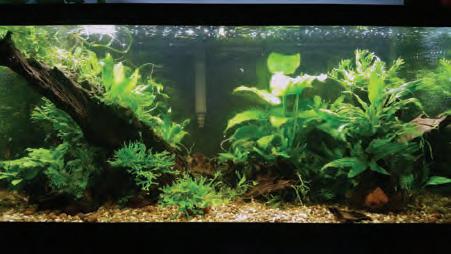



Below are photo submissions to our “Fishy Friends” Facebook group. I’ve left the subjects unnamed, but not the photographer. If you see a shot you like, and want more info, ask the photographer about it! I’m sure he or she will be delighted to tell you!
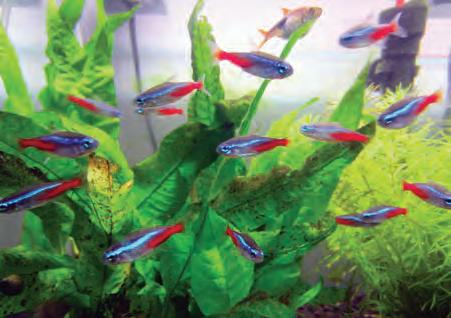
Modern Aquarium - Greater City A.S (NY) September 2019 19
Joe Gurrado
Gilberto Soriano
Steve Sica
Joe Gurrado
Andrew Jouan
Ruben Lugo
There is a Bowl Show at every GCAS meeting, except our Night at the Auction meeting (August) and our Holiday Party and Awards Banquet meeting (December). These shows are open to all members of GCAS. Rules are as follows:

Modern Aquarium - Greater City A.S (NY) 20 September 2019
Why Did the Turtle Cross the Road?

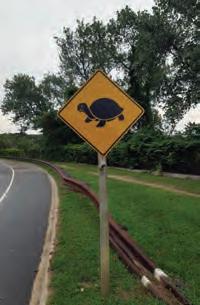 Story and Photos by Ronald G. Webb
Story and Photos by Ronald G. Webb
Driving in New York and other states I have seen signs for cow crossings, deer crossings, and even duck crossings—but turtle crossings? Well, such a sign does exist near Hempstead Lake State Park, and for good reason; turtles do cross roads. Some crossings are more successful than others. On the way home from one of many morning fishing trips, I was driving along Peninsula Blvd, where the posted speed limit is 45 mph. Cars rarely go the speed limit however, and the norm on this road is 55 to 60 mph. As I was coming around a curve near South Pond in Rockville Centre, I spotted something in the road, and swerved around what turned out to be a turtle making its way away from the lake toward civilization.
When I stopped at the next traffic light, I thought about the certain plight of this critter, and I made a decision to go back and try to rescue it—I just felt it was the right thing to do. I made a U-turn and drove back to the area, parked my car, and grabbed a canvas shopping bag out of my trunk. I walked back along the side of the road and found the turtle, but it was now on its back, as a car had just run directly over it and flipped it over. It looked like it was possibly uninjured, but I couldn’t tell until I made my way out onto the busy road. I waited until there was a break in the flow of traffic, and crossed two northbound lanes and then into the southbound lane, grabbed the turtle, and quickly stuffed it into the shopping bag.
After crossing back to the other side of the road and into the safety of my car, I had a chance to look at this very fortunate animal. To say it was “shell shocked” or “turtled up” would be an understatement. However, there were no apparent physical injuries, so I decided to take it home.
I got a Tupperware tub and added a bit of water and some romaine lettuce, in the hope that it would recover from its harrowing ordeal. I called my neighbor Ed Vukich, and asked him if he thought Harry Faustmann might want this slider turtle for his backyard pond. Ed called Harry, who said he would take the turtle in. I was happy to think that this turtle would now live out his years in a private pond
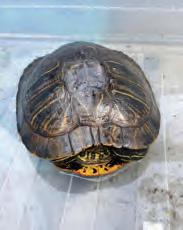
paradise. Well, the turtle hadn’t moved since I plucked him off the road a few hours previous. Since it was a Sunday and we were heading down to the beach for the afternoon, I put the tub in a shady part of my yard and set off to the beach. I told Ed where he would find the turtle, and I didn’t give it another thought. The turtle still hadn’t moved since I’d brought it home, and one last check before I left still revealed no movement of any kind.
A few hours later while I was at the beach, I got a call from Ed saying that there was no turtle in the tub. So this seemingly shell-shocked turtle had recovered enough to make an improbable jailbreak? When I returned home I searched my fencedin yard, figuring I would find this escape artist with little to no effort. However, after searching my yard and my neighbor’s yards to no avail, I couldn’t figure where and how far this turtle might have gone!
Sunday turned into Monday, and still there was no sign of the turtle. At this point I had figured that it was either still hiding somewhere or someone had found it. Well as it turned out, this turtle had been rescued a second time—with an unlikely assist from Facebook.
A friend of my daughter’s had posted a picture of the escaped turtle on Facebook, and figured it was somebody’s lost pet. The amazing part of this story is that this turtle not only escaped under the vinyl fence in my yard and crossed my street, it went through another two front and back yards, crossed another street, and wound up a block away from my house! Talk about determination!
I was able to get the turtle back on Monday evening after work. I put it in a three-foot deep tub with no chance of escape this time. I also put a cover on the tub, just to be double sure. Ed stopped by Tuesday morning and drove it over to Harry’s pond, hopefully its final stop, and the rest is history. I don’t think this guy has escaped Harry’s pond yet…
Modern Aquarium - Greater City A.S (NY) September 2019 21
Pictures From



Modern Aquarium - Greater City A.S (NY) 22 September 2019
Photos by Marsha Radebaugh
The crowd grows restless with anticipation.
Runner Temes Mo consults with Auctioneer Ed Vukich on an auction item.
The auction action picks up.
Our Last Meeting and
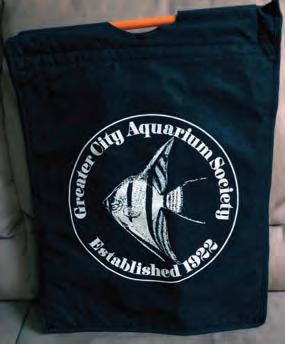


Larry Whitfield

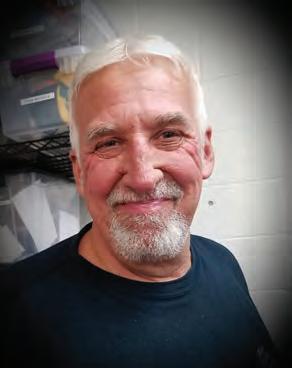



Modern Aquarium - Greater City A.S (NY) September 2019 23
Joe Gurrado with Frank Doka
From left: New members Frank Doka, Mike Hernandez, and Richard Marino.
New member Brett Felmer Our New GCAS Fish Bag








Modern Aquarium - Greater City A.S (NY) 24 September 2019 10% Discount on everything except ʽon saleʼ items. 20% Discount on fish. 15% on all else. 10% Discount on everything. 10% Discount on everything. 10% Discount on everything. 10% Discount on fish. 10% Discount on everything.
10% Discount on everything.
GCAS Member Discounts at Local Fish Shops



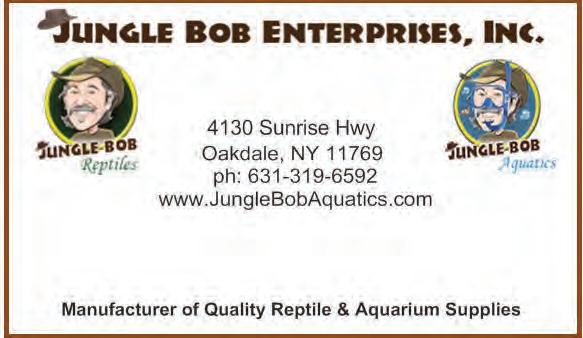


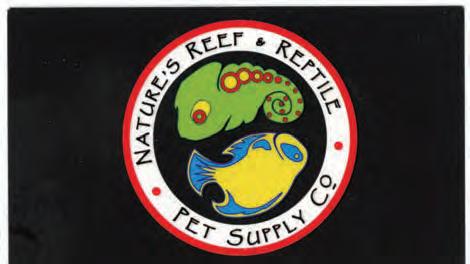

Modern Aquarium - Greater City A.S (NY) September 2019 25 10% Discount on everything. GCAS Classifieds 10% Discount on everything. 10% Discount on everything. 15% Discount on everything in store, or online at: http://www.junglebobaquatics.com Use coupon code gcas15. FOR SALE: African cichlids -- all sizes, as well as tanks and accessories. Call Derek (917) 854-4405 FOR SALE: Coralife 9-Watt Turbo-Swift U/V, bulb recently replaced. Call Kris: 516-282-6677 --------------------------------------------------------------------------------------------------------------------------
GCAS Happenings September
Last Month’s Bowl Show Winners: No Bowl Show Last Month
Unofficial 2019 Bowl Show totals:
Richard Waizman 24 William Amely 7 Christopher Koenig 5
John Buzzetti 5 Tom Keegan 3
Meeting times and locations of some of the aquarium societies in the Metropolitan New York City area:
G REATER C ITY Aq UARIUM S OCIETY
Next Meeting: Wednesday, october 2, 2019
Speaker: Jim Cumming
Topic: Madagascar and Indian Cichlids
Meets: The first Wednesday of each month (except January & February) at 7:30pm: Queens Botanical Garden
43-50 Main Street - Flushing, NY
Contact: horst Gerber (718) 885-3071
Email: pilotcove43@gmail.com
Website: http://www.greatercity.net
B IG A PPLE G UPPY C LUB
Meets: Last tuesday each month (except Jan, Feb, July, and august) at 7:30-10:00pm. alley Pond Environmental Ctr.: 228-06 Northern Blvd.
Contact: donald Curtin (718) 631-0538
B ROOKLYN Aq UARIUM S OCIETY
Next Meeting: october 11, 2019
Speaker: None
Event: Giant Auction
Meets: 2nd Friday of the month (except July and august) at 7:30pm: NY aquarium - Education hall, Brooklyn, NY
Call: BaS Events hotline: (718) 837-4455
Website: http://www.brooklynaquariumsociety.org

L ONG I SLAND Aq UARIUM S OCIETY
Next Meeting: September 20, 2019
Speaker: tBd
Topic: TBA
Meets: 3rd Friday of each month (except July and august) at 8:00 PM. LiaS Meetings are held at SUNY Stony Brook's Maritime Science area. Room 120 in Endeavor hall on the State University at Stony Brook Campus, Stony Brook, NY 11790
Email: president@liasonline.org
Website: http://liasonline.org/
!
E AST C OAST G UPPY A SSOCIATION
Meets: 2nd Tuesday of each month at 8:00 pm at alley Pond Environmental Ctr.: 228-06 Northern Blvd.
Contact: Gene Baudier (631) 345-6399
N ASSAU C OUNTY Aq UARIUM S OCIETY

Next Meeting: September 10, 2019
Speaker: tBa
Topic: TBA
Meets: 2nd Tuesday of the month (except July and august) at 7:30 PM. Molloy College, at 1000 hempstead avenue, Rockville Centre, NY, in the PUBLiC SQUaRE BUILDING, room 209A. See website for directions.
Contact: harry W. Faustmann, (516) 804-4752.
Website: http://www.ncasweb.org
NORTH JERSEY AqUARIUM SOCIETY



Next Meeting: September 21, 2019
Speaker: tony terciera
Topic: Killifish Husbandry, Fish Photography
Meets: 12:30 PM - 3rd Saturday of the month, at Clark Public Library in Union County, just off the Parkway at exit 135
Contact: NJaS hotline at (732) 332-1392
Email: tcoletti@obius.jnj.com
Website: http://www.njas.net/


N ORWALK Aq UARIUM S OCIETY
Next Meeting: September 19, 2019
Speaker: Jeff Michels
Topic: Apistogramma
Meets: 8:00 P.M. - 3rd Thursday of each month except for July & December at: Earthplace - the Nature discovery Center - Westport, Ct

Contact: Sal Silvestri
Call our toll free number (866) 219-4NAS
Email: salsilv44@yahoo.com
Website: http://norwalkas.org/
Modern Aquarium - Greater City A.S (NY) 26 September 2019
A special welcome to new GCAS members Frank Doka, Brett Felmer, Mike Hernandez, and Richard Marino
In spite of popular demand to the contrary, this humor and information column continues. As usual, it does NOT necessarily represent the opinions of the Editor, or of the Greater City Aquarium Society


A series by “The Undergravel Reporter”
The movie “The Godfather” popularized the phrase “sleeping with the fishes.” This column has, in the past, reported on beds with built-in fish tanks and hotel rooms with bedrooms with views of live fish. A café in Japan provides a somewhat different experience: pooping with the fishes.
A Japanese café has become “flush” with success, thanks to its bizarre toilet, essentially inside a huge aquarium. When nature calls for visitors to the Hipopo Papa Café, in Akashi on the Hayashizaki Matsue Coast, they can relieve themselves on a toilet that’s surrounded on three sides by exotic fish, and a male turtle.

The owner of the cafe reportedly spent over £200,000 (about $241,840 USD) installing the unusual facility.
The bathroom has been designated for women, but as long as the cafe isn't too crowded, staff will allow men to go in and take a peek.
The café’s staff have found that some customers spend more time in the toilet admiring the fish than they do buying items from the café.
Meanwhile some customers have remarked that they are too scared to use the toilet. They believe that relieving themselves in close proximity to sea creatures would be a distinctly uncomfortable experience.
The Japanese are known for having the world’s most hi-tech toilets. Some have auto-shutting lids and massage functions.
OK, some questions: can you do water changes just by flushing? And, when you flush, where does your detritus go? (hopefully, not as fish food)!?
Reference:
https://www.dailymail.co.uk/travel/travel_news/article-6923245/Japans-Hipopo-Papa-Cafe-spends200k-installing-toilet-thats-surrounded-huge-fish-tank.html
Modern Aquarium - Greater City A.S (NY) September 2019 27
Modern Aquarium - Greater City A.S. (NY)September 2019 17
Fin Fun
This month’s Modern Aquarium has a story of a turtle who finally found itself in the pond of one of our members. Let’s see if you can guide the turtle in the maze below to this pond.

Solution to our last puzzle:
Asia
Africa
Mastacembelus armatus (Tire track eel)
Barbus trimaculatus (Threespot barb)
Europe Knipowitschia punctatissima (Italian spring goby)
North America
South America

Notropis lutrensis (Red shiner)


Astronotus ocellatus (Oscar)
Australia Melanotaenia duboulayi (Crimson spotted rainbowfish)
Modern Aquarium - Greater City A.S (NY) 28 September 2019
24 September 2019Modern Aquarium - Greater City A.S. (NY)

24








 by Horst Gerber
by Horst Gerber

















































 Story and Photos by Ronald G. Webb
Story and Photos by Ronald G. Webb









































